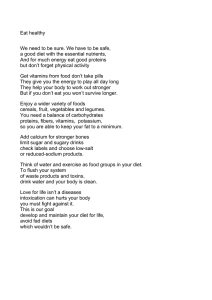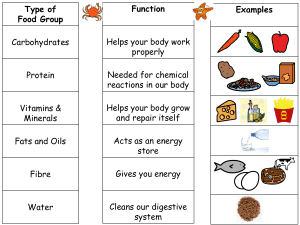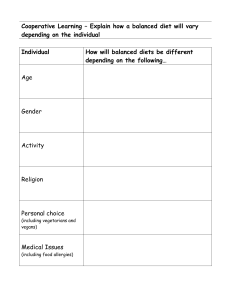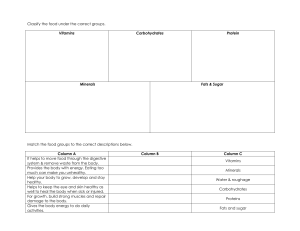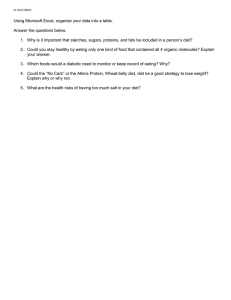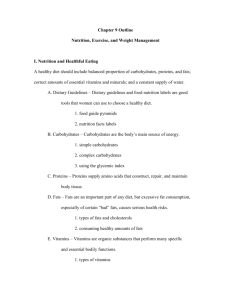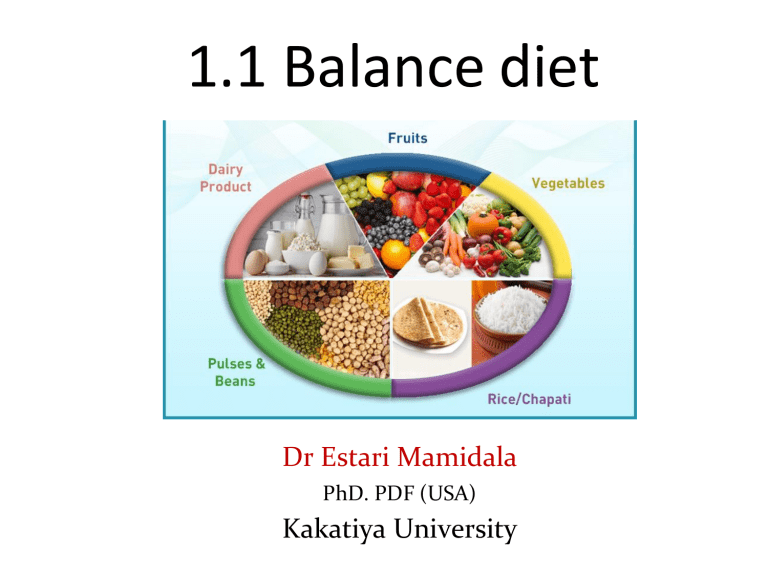
1.1 Balance diet Dr Estari Mamidala PhD. PDF (USA) Kakatiya University What is a Balanced Diet ? Balance diet • • • • • • • • Elements Food groups Daily aoowence Nutritive value of food Calculation of balance diet Planning menu Budgeting of food Therapeutics diet Definition of a Balanced Diet: • A balanced diet is food intake that includes all of the dietary needs of the organism in the correct proportions. • In the case of a balanced human adult diet, this is sometimes specified as approx. • 1/7 fat • 1/7 protein • 5/7 carbohydrate Which food groups must be included in a balanced diet ? • Carbohydrates • Proteins • Fats (also called "Lipids"), see saturated vs unsaturated fats • Dietary Fibre (also called "Roughage") • Water • Vitamins • Minerals Carbohydrates • Carbohydrates are broken-down by the digestive system into energy in the form of glucose (which can be absorbed into the blood). Note that if the body is supplied with too much ingested energy in the form of food the excess may be laid down as fat around the body - as the body's "energy store" or "reserve" in case it is needed later. • The body needs and uses energy for the following: • Active transport • Synthesis of biochemical macromolecules • Cell division • Muscle contraction Proteins • Proteins are often described as "building blocks" essential for growth (especially in the case of infants, children and body-builders) and for maintenance and repair of body tissues. After processing via the digestive system, the components of proteins are used in body tissues. • Proteins are broken-down by the digestive system into amino acids (which can be absorbed into the blood). This is sometimes stated in the opposite way, i.e. in terms of proteins "containing" amino acids. There are different types of proteins found in a wide range of animal and non-animal food sources e.g. meat, fish, eggs, pulses and beans. A balanced diet includes all of the essential amino acids, which are so-called because they are needed but cannot be synthesized by the human body. Fats (= Lipids) • Some fats (also known as "lipids") are essential for a healthy balanced diet. They are broken-down by the digestive system into fatty acids and glycerol. These compounds are then used in cell membranes and as parts to form steroid hormones. • In terms of their chemistry, lipids are highly reduced organic compounds, hence they can be oxidized to release energy. (As explained on the page about metabolic rate, energy is measured in calories; "high energy" = "high calorie" and if and when a person ingests more energy in food than he/she uses in bodily activities the excess energy is stored as fat in the body's tissues.) • There are many different fat molecules but in general fats can be divided into two main groups: • Saturated fats and cholesterol - typically derived from animal products such as meats • Unsaturated fats - typically from plant sources such as soya Dietary Fibre • Dietary Fibre (roughage) is important for a balanced diet. It consists mainly of cellulose from plant cell walls and is part of many plantbased food sources, including fresh fruits and vegetables and whole grains and pulses. The main functions of dietary fibre concern the health of the large intestine, incl. helping to form soft bulky faeces, thereby easing defecation and reducing the probability of constipation. Water • Water is an essential part of the human diet. It is necessary for the body in which it is used as a solvent, a transport medium, a substrate in hydrolytic reactions and for lubrication. • Although humans need water every day it is not necessary consumed in the form of drinking water itself but as the major part of many drinks and some liquid or partially foods such as soups, sauces, dressings and icedesserts. Vitamins • There are many different vitamins. Although all vitamins are organic compounds, they have no common chemical structure or functions. Vitamins are specific chemicals needed by the body in relatively small amounts. Collectively they fulfil a wide range of functions including enabling the body to make efficient use of other parts of a balanced diet, e.g. vitamin D facilitates absorption of calcium and phosphorous. • There are two important groups, or types, of vitamins: • Water-soluble Vitamins e.g. C and the B vitamins - in many fruits and vegetables • Fat-soluble Vitamins e.g. A, D and E - in fatty foods e.g. many diary products Minerals • Unlike vitamins (which are organic compounds), minerals are chemical elements. • There are two important groups, or types, of minerals: • Macro Minerals - found in typical adult human bodies in quantities > 5g ; > 100mg needed daily • Micro Minerals - found in typical adult human bodies in quantities < 5g ; 1-100mg needed daily • Roles of specific minerals: Individual minerals have specific purposes. • Examples include calcium in bones and teeth, and sodium in glucose uptake Role of minerals (in general / collectively): • Minerals help to maintain ideal concentrations of tiny amounts of chemicals (called solutes) dissolved in the water present in the tissues of the body (strictly, that "water" is a solution of those particles in the water) so that the solution moves around and through the body's tissues in the most beneficial way for the overall health of the organism, i.e. person. • Minerals are usually ingested as part of some of the main food types, e.g. calcium (Ca) in dairy foods, and iron (Fe) in read meats. However, some people take supplements of certain minerals e.g. in tablet form - especially if following a restricted diet, or sometimes due to certain medical conditions. Therapeutics diet • Design for special purpose • Dietory si • Uppliments • Eg malnutrition child • Mixture of protein • The End
